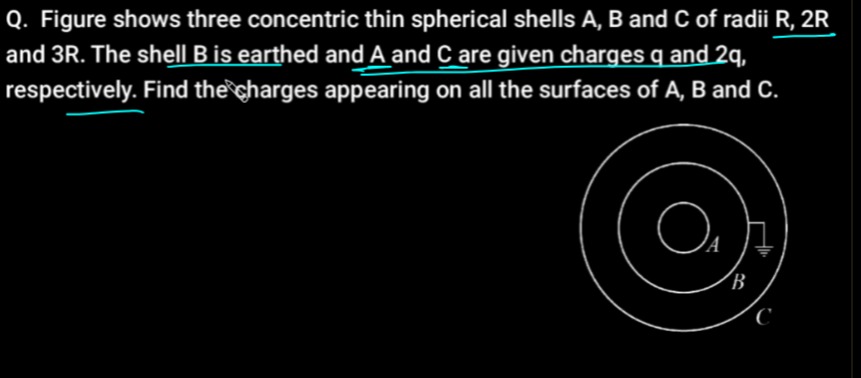Question
Question: Figure shows three concentric thin spherical shells A, B and C of radii R, 2R and 3R. The shell B is...
Figure shows three concentric thin spherical shells A, B and C of radii R, 2R and 3R. The shell B is earthed and A and C are given charges q and 2q, respectively. Find the charges appearing on all the surfaces of A, B and C.

q_{A,in}=0, q_{A,out}=q, q_{B,in}=-q, q_{B,out}=-4q/3, q_{C,in}=4q/3, q_{C,out}=2q/3
Solution
The charges on the surfaces of the spherical shells are determined by the given total charges and the earthing condition of shell B. Let the radii of shells A, B, and C be R, 2R, and 3R, respectively. Shell A has total charge qA=q, shell B has total charge qB, and shell C has total charge qC=2q. Shell B is earthed, so its potential is zero (VB=0).
-
Shell A (radius R, total charge q): Since there is no charge at the center, the electric field inside the conductor of A is zero. This means the charge on the inner surface of A is zero. Thus, the entire charge q resides on the outer surface of A. qA,in=0 qA,out=q
-
Shell B (radius 2R, earthed): The inner surface of shell B faces the outer surface of shell A, which has charge q. By electrostatic induction, a charge equal and opposite to the charge on the outer surface of A will be induced on the inner surface of B. qB,in=−qA,out=−q.
Let the charge on the outer surface of B be qB,out. The total charge on B is qB=qB,in+qB,out=−q+qB,out. Since shell B is earthed, its potential is zero. The potential at the surface of shell B (at radius 2R) is the sum of potentials due to the charges on A, B, and C. Potential at radius r due to a spherical shell of radius r′ and charge Q′ is 4πϵ01rQ′ for r≥r′ and 4πϵ01r′Q′ for r<r′.
Potential at 2R due to charge qA,out on outer surface of A (at R): VA=4πϵ012RqA,out=4πϵ012Rq. Potential at 2R due to charge qB,in on inner surface of B (at 2R): VB,in=4πϵ012RqB,in=4πϵ012R−q. Potential at 2R due to charge qB,out on outer surface of B (at 2R): VB,out=4πϵ012RqB,out. Potential at 2R due to total charge qC on shell C (at 3R): VC=4πϵ013RqC=4πϵ013R2q. Note that for calculating the potential at 2R due to shell C, we use the total charge on C because 2R < 3R, so the potential is the same as if the total charge was at the radius of C.
The total potential at the surface of B is VB=VA+VB,in+VB,out+VC=0. 4πϵ01(2Rq+2R−q+2RqB,out+3R2q)=0. 2RqB,out+3R2q=0. 2qB,out+32q=0. qB,out=−2×32q=−34q.
Total charge on B is qB=qB,in+qB,out=−q−34q=−37q.
-
Shell C (radius 3R, total charge 2q): The inner surface of shell C faces the outer surface of shell B, which has charge qB,out. However, the induced charge on the inner surface of C is due to the total charge inside C. The total charge inside C is the sum of the total charge on A and the total charge on B. Total charge inside C = qA+qB=q+(−37q)=33q−7q=−34q. By electrostatic induction, the charge on the inner surface of C is the negative of the total charge inside C. qC,in=−(−34q)=34q.
The total charge on shell C is qC=qC,in+qC,out=2q. So, 34q+qC,out=2q. qC,out=2q−34q=36q−4q=32q.
Summary of charges on all surfaces: Shell A: Inner surface qA,in=0, Outer surface qA,out=q. Shell B: Inner surface qB,in=−q, Outer surface qB,out=−34q. Shell C: Inner surface qC,in=34q, Outer surface qC,out=32q.
Explanation of the solution:
- For shell A, since there is no charge in the cavity, the charge resides on the outer surface.
- For shell B, the inner surface charge is induced by the charge on the outer surface of A. The outer surface charge is determined by the condition that the potential of shell B is zero. The potential of B is the sum of potentials due to charges on A, B, and C.
- For shell C, the inner surface charge is induced by the total charge inside C (charge on A and total charge on B). The outer surface charge is then determined by the total charge on C.
